check engine BMW ACTIVE HYBRID 3 2015 F30H Owner's Guide
[x] Cancel search | Manufacturer: BMW, Model Year: 2015, Model line: ACTIVE HYBRID 3, Model: BMW ACTIVE HYBRID 3 2015 F30HPages: 251, PDF Size: 5.49 MB
Page 212 of 251
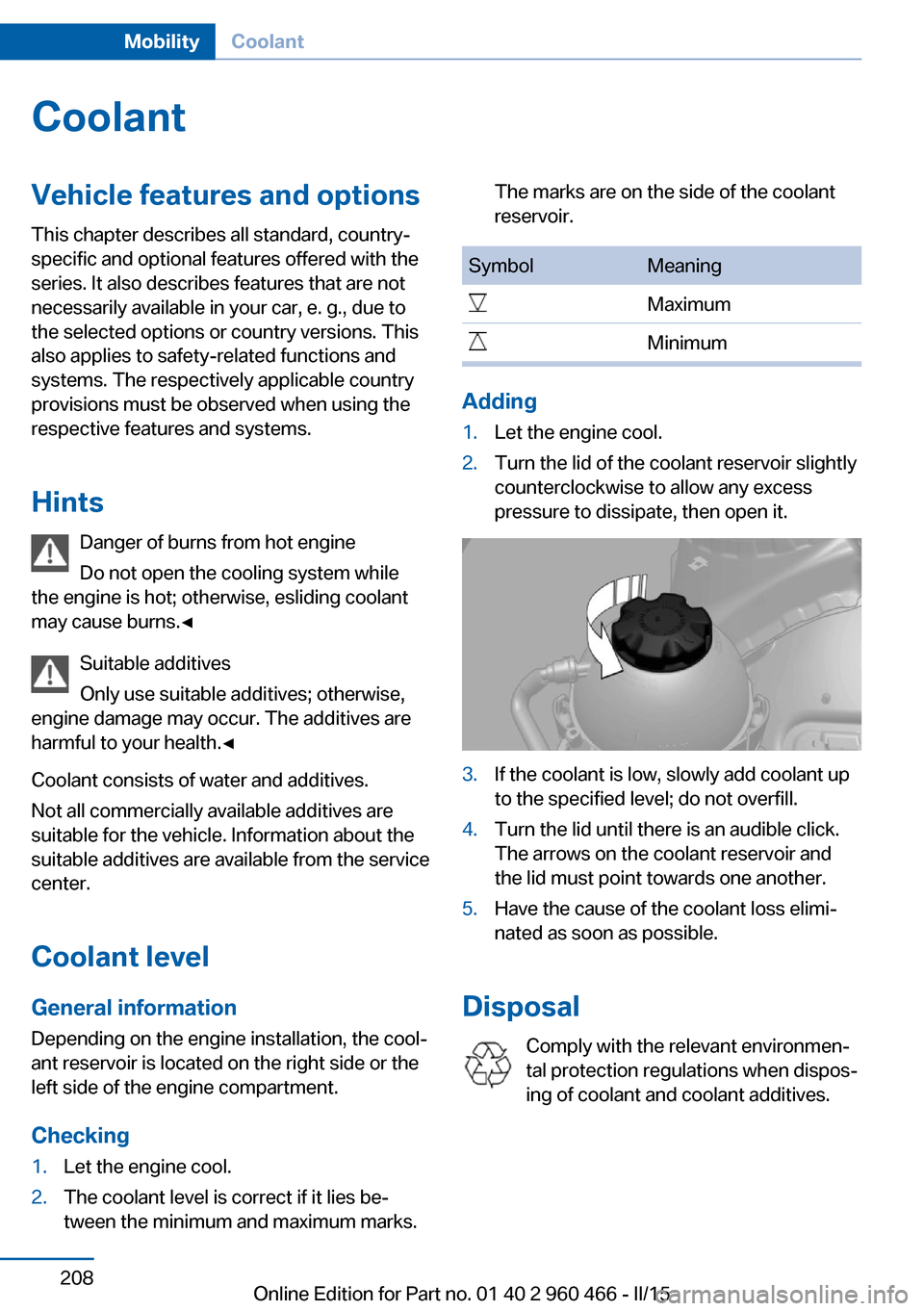
CoolantVehicle features and optionsThis chapter describes all standard, country-
specific and optional features offered with the
series. It also describes features that are not
necessarily available in your car, e. g., due to
the selected options or country versions. This
also applies to safety-related functions and
systems. The respectively applicable country
provisions must be observed when using the
respective features and systems.
Hints Danger of burns from hot engine
Do not open the cooling system while
the engine is hot; otherwise, esliding coolant
may cause burns.◀
Suitable additives
Only use suitable additives; otherwise,
engine damage may occur. The additives are
harmful to your health.◀
Coolant consists of water and additives.
Not all commercially available additives are
suitable for the vehicle. Information about the
suitable additives are available from the service
center.
Coolant level
General information
Depending on the engine installation, the cool‐
ant reservoir is located on the right side or the
left side of the engine compartment.
Checking1.Let the engine cool.2.The coolant level is correct if it lies be‐
tween the minimum and maximum marks.The marks are on the side of the coolant
reservoir.SymbolMeaningMaximumMinimum
Adding
1.Let the engine cool.2.Turn the lid of the coolant reservoir slightly
counterclockwise to allow any excess
pressure to dissipate, then open it.3.If the coolant is low, slowly add coolant up
to the specified level; do not overfill.4.Turn the lid until there is an audible click.
The arrows on the coolant reservoir and
the lid must point towards one another.5.Have the cause of the coolant loss elimi‐
nated as soon as possible.
Disposal
Comply with the relevant environmen‐
tal protection regulations when dispos‐
ing of coolant and coolant additives.
Seite 208MobilityCoolant208
Online Edition for Part no. 01 40 2 960 466 - II/15
Page 213 of 251

MaintenanceVehicle features and options
This chapter describes all standard, country-
specific and optional features offered with the
series. It also describes features that are not
necessarily available in your car, e. g., due to
the selected options or country versions. This
also applies to safety-related functions and
systems. The respectively applicable country
provisions must be observed when using the
respective features and systems.
BMW maintenance system The maintenance system indicates required
maintenance measures, and thereby provides
support in maintaining road safety and the op‐
erational reliability of the vehicle.
In some cases scopes and intervals may vary
according to the country-specific version. Re‐
placement work, spare parts, fuels and lubri‐
cants and wear materials are calculated sepa‐
rately. Additional information is available from
the service center.
Condition Based Service
CBS
Sensors and special algorithms take into ac‐
count the driving conditions of your vehicle.
Based on this, Condition Based Service recog‐
nizes the maintenance requirements.
The system makes it possible to adapt the
amount of maintenance corresponding to your
user profile.
Detailed information on service requirements,
refer to page 89, can be displayed on the Con‐
trol Display.Service data in the remote control
Information on the required maintenance is
continuously stored in the remote control. Your service center will read out this data and
suggest the right array of service procedures for your vehicle.
Therefore, hand your service specialist the re‐
mote control with which the vehicle was driven
most recently.
Storage periods Storage periods during which the vehicle bat‐
tery was disconnected are not taken into ac‐
count.
If this occurs, have a service center update the
time-dependent maintenance procedures,
such as checking brake fluid and, if needed,
changing the engine oil and the microfilter/
activated-charcoal filter.
Service and Warranty
Information Booklet for US
models and Warranty and
Service Guide Booklet for
Canadian models
Please consult your Service and Warranty In‐
formation Booklet for US models and Warranty
and Service Guide Booklet for Canadian mod‐
els for additional information on service re‐
quirements.
Maintenance and repair should be performed
by your service center. Make sure to have reg‐
ular maintenance procedures recorded in the
vehicle's Service and Warranty Information
Booklet for US models, and in the Warranty
and Service Guide Booklet for Canadian mod‐
els. These entries are proof of regular mainte‐
nance.Seite 209MaintenanceMobility209
Online Edition for Part no. 01 40 2 960 466 - II/15
Page 214 of 251
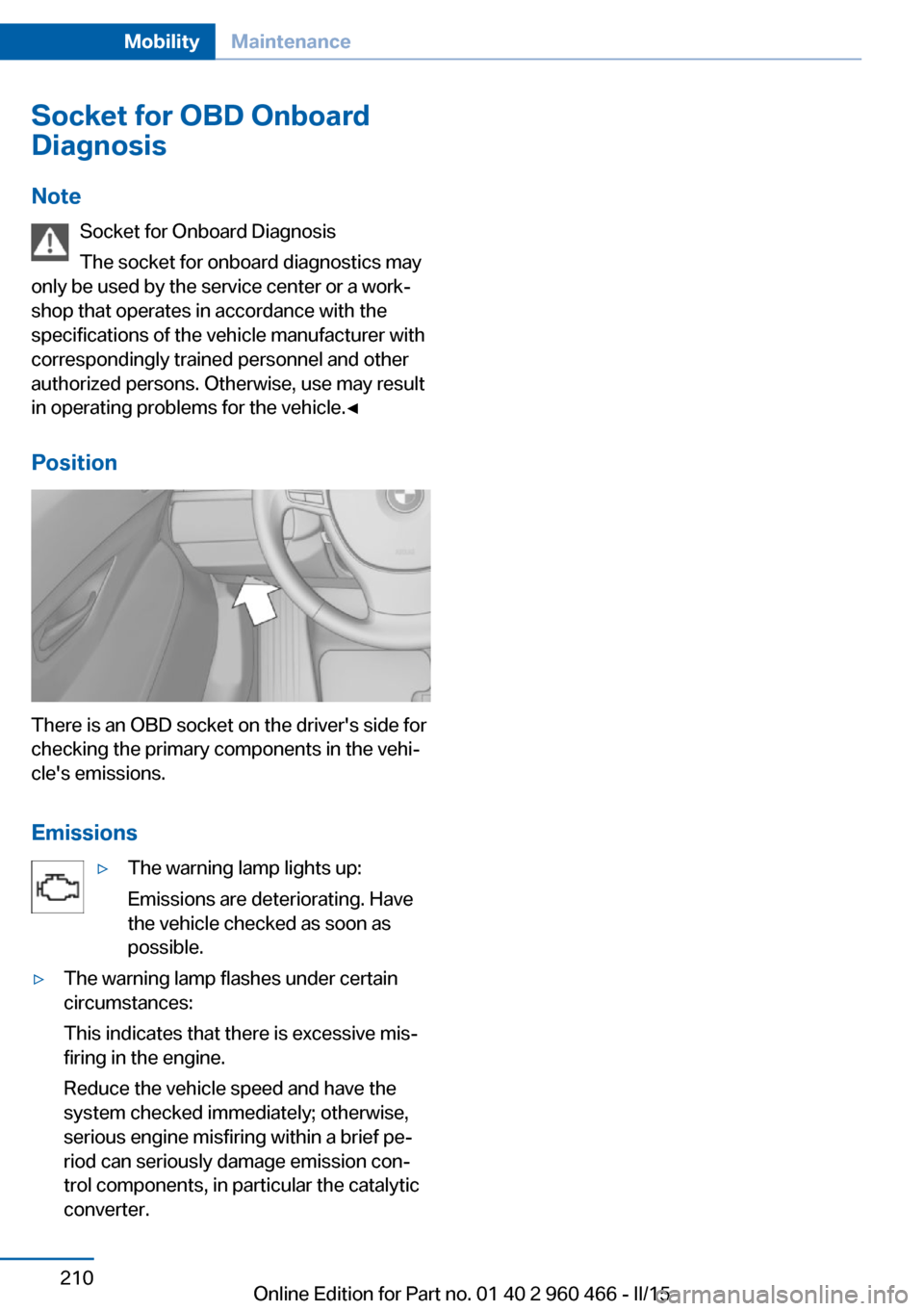
Socket for OBD Onboard
Diagnosis
Note Socket for Onboard Diagnosis
The socket for onboard diagnostics may
only be used by the service center or a work‐
shop that operates in accordance with the
specifications of the vehicle manufacturer with
correspondingly trained personnel and other
authorized persons. Otherwise, use may result
in operating problems for the vehicle.◀
Position
There is an OBD socket on the driver's side for
checking the primary components in the vehi‐
cle's emissions.
Emissions
▷The warning lamp lights up:
Emissions are deteriorating. Have
the vehicle checked as soon as
possible.▷The warning lamp flashes under certain
circumstances:
This indicates that there is excessive mis‐
firing in the engine.
Reduce the vehicle speed and have the
system checked immediately; otherwise,
serious engine misfiring within a brief pe‐
riod can seriously damage emission con‐
trol components, in particular the catalytic
converter.Seite 210MobilityMaintenance210
Online Edition for Part no. 01 40 2 960 466 - II/15
Page 224 of 251
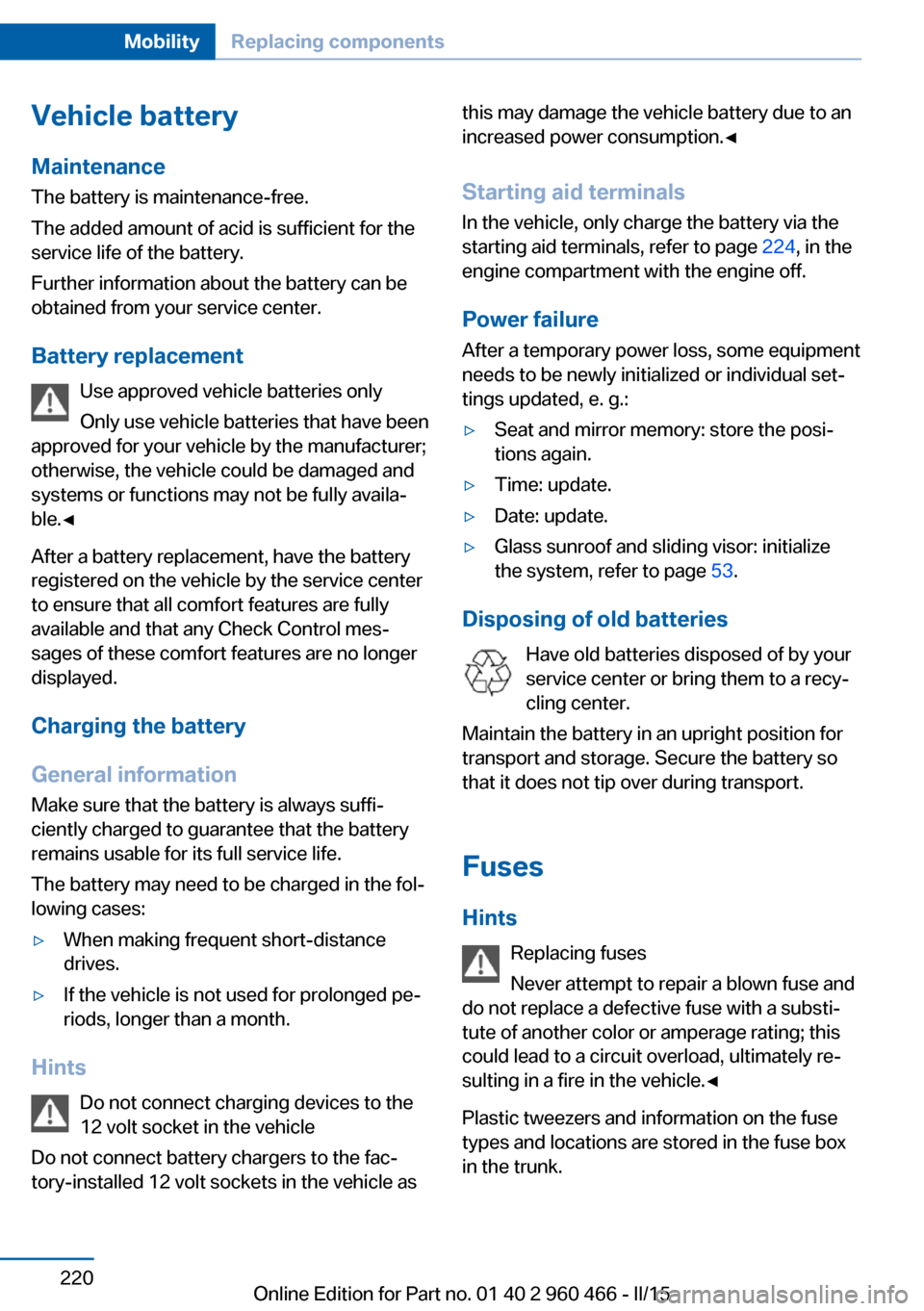
Vehicle batteryMaintenance
The battery is maintenance-free.
The added amount of acid is sufficient for the
service life of the battery.
Further information about the battery can be
obtained from your service center.
Battery replacement Use approved vehicle batteries only
Only use vehicle batteries that have been
approved for your vehicle by the manufacturer;
otherwise, the vehicle could be damaged and
systems or functions may not be fully availa‐
ble.◀
After a battery replacement, have the battery
registered on the vehicle by the service center
to ensure that all comfort features are fully
available and that any Check Control mes‐
sages of these comfort features are no longer
displayed.
Charging the battery
General information Make sure that the battery is always suffi‐
ciently charged to guarantee that the battery
remains usable for its full service life.
The battery may need to be charged in the fol‐
lowing cases:▷When making frequent short-distance
drives.▷If the vehicle is not used for prolonged pe‐
riods, longer than a month.
Hints
Do not connect charging devices to the
12 volt socket in the vehicle
Do not connect battery chargers to the fac‐
tory-installed 12 volt sockets in the vehicle as
this may damage the vehicle battery due to an
increased power consumption.◀
Starting aid terminals In the vehicle, only charge the battery via thestarting aid terminals, refer to page 224, in the
engine compartment with the engine off.
Power failure After a temporary power loss, some equipment
needs to be newly initialized or individual set‐
tings updated, e. g.:▷Seat and mirror memory: store the posi‐
tions again.▷Time: update.▷Date: update.▷Glass sunroof and sliding visor: initialize
the system, refer to page 53.
Disposing of old batteries
Have old batteries disposed of by your
service center or bring them to a recy‐
cling center.
Maintain the battery in an upright position for
transport and storage. Secure the battery so
that it does not tip over during transport.
Fuses Hints Replacing fuses
Never attempt to repair a blown fuse and
do not replace a defective fuse with a substi‐
tute of another color or amperage rating; this
could lead to a circuit overload, ultimately re‐
sulting in a fire in the vehicle.◀
Plastic tweezers and information on the fuse
types and locations are stored in the fuse box
in the trunk.
Seite 220MobilityReplacing components220
Online Edition for Part no. 01 40 2 960 466 - II/15
Page 227 of 251
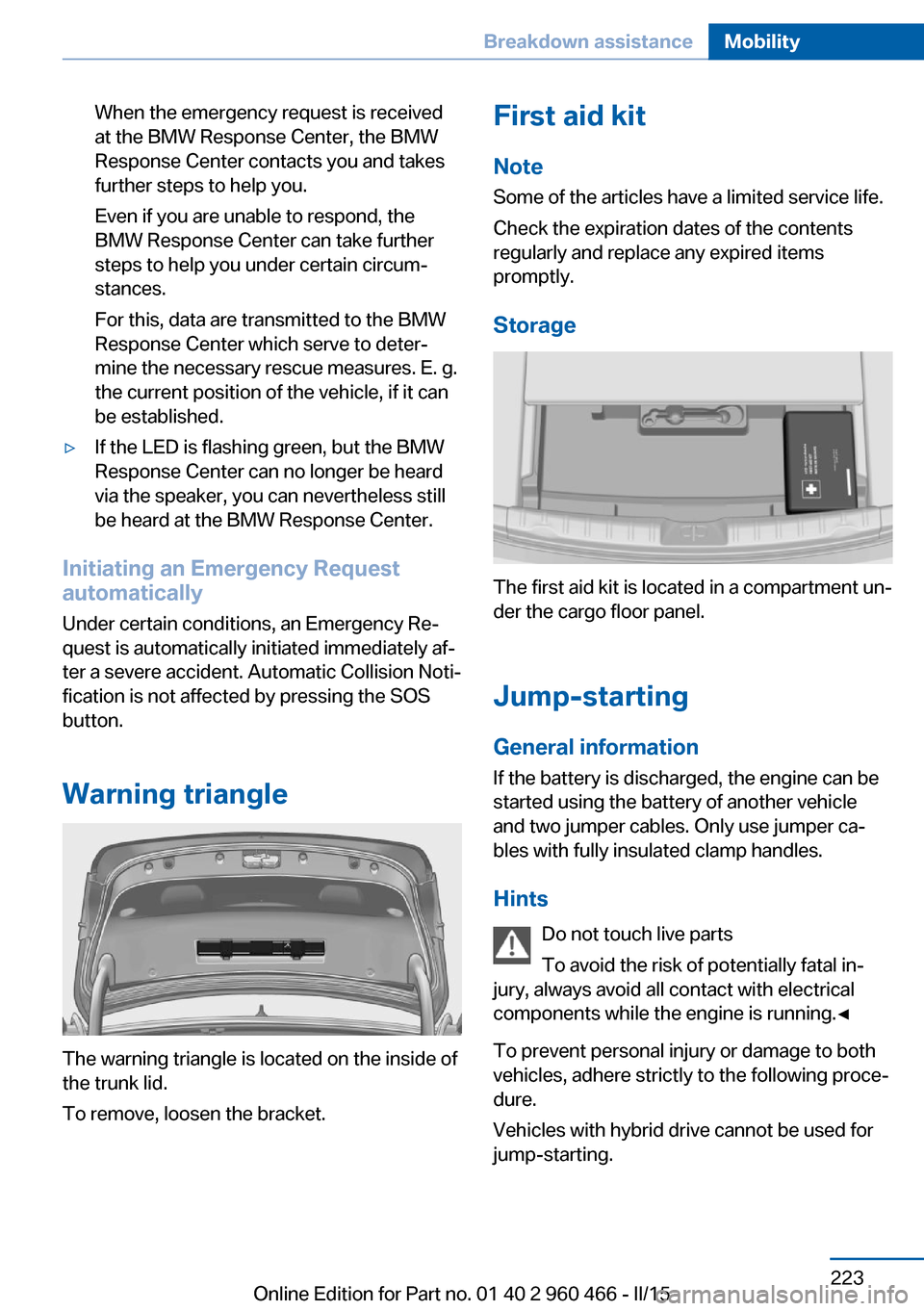
When the emergency request is received
at the BMW Response Center, the BMW
Response Center contacts you and takes
further steps to help you.
Even if you are unable to respond, the
BMW Response Center can take further
steps to help you under certain circum‐
stances.
For this, data are transmitted to the BMW
Response Center which serve to deter‐
mine the necessary rescue measures. E. g.
the current position of the vehicle, if it can
be established.▷If the LED is flashing green, but the BMW
Response Center can no longer be heard
via the speaker, you can nevertheless still
be heard at the BMW Response Center.
Initiating an Emergency Request
automatically
Under certain conditions, an Emergency Re‐
quest is automatically initiated immediately af‐
ter a severe accident. Automatic Collision Noti‐
fication is not affected by pressing the SOS
button.
Warning triangle
The warning triangle is located on the inside of
the trunk lid.
To remove, loosen the bracket.
First aid kit
Note
Some of the articles have a limited service life.
Check the expiration dates of the contents
regularly and replace any expired items
promptly.
Storage
The first aid kit is located in a compartment un‐
der the cargo floor panel.
Jump-starting
General information If the battery is discharged, the engine can be
started using the battery of another vehicle
and two jumper cables. Only use jumper ca‐
bles with fully insulated clamp handles.
Hints Do not touch live parts
To avoid the risk of potentially fatal in‐
jury, always avoid all contact with electrical
components while the engine is running.◀
To prevent personal injury or damage to both
vehicles, adhere strictly to the following proce‐
dure.
Vehicles with hybrid drive cannot be used for
jump-starting.
Seite 223Breakdown assistanceMobility223
Online Edition for Part no. 01 40 2 960 466 - II/15
Page 228 of 251
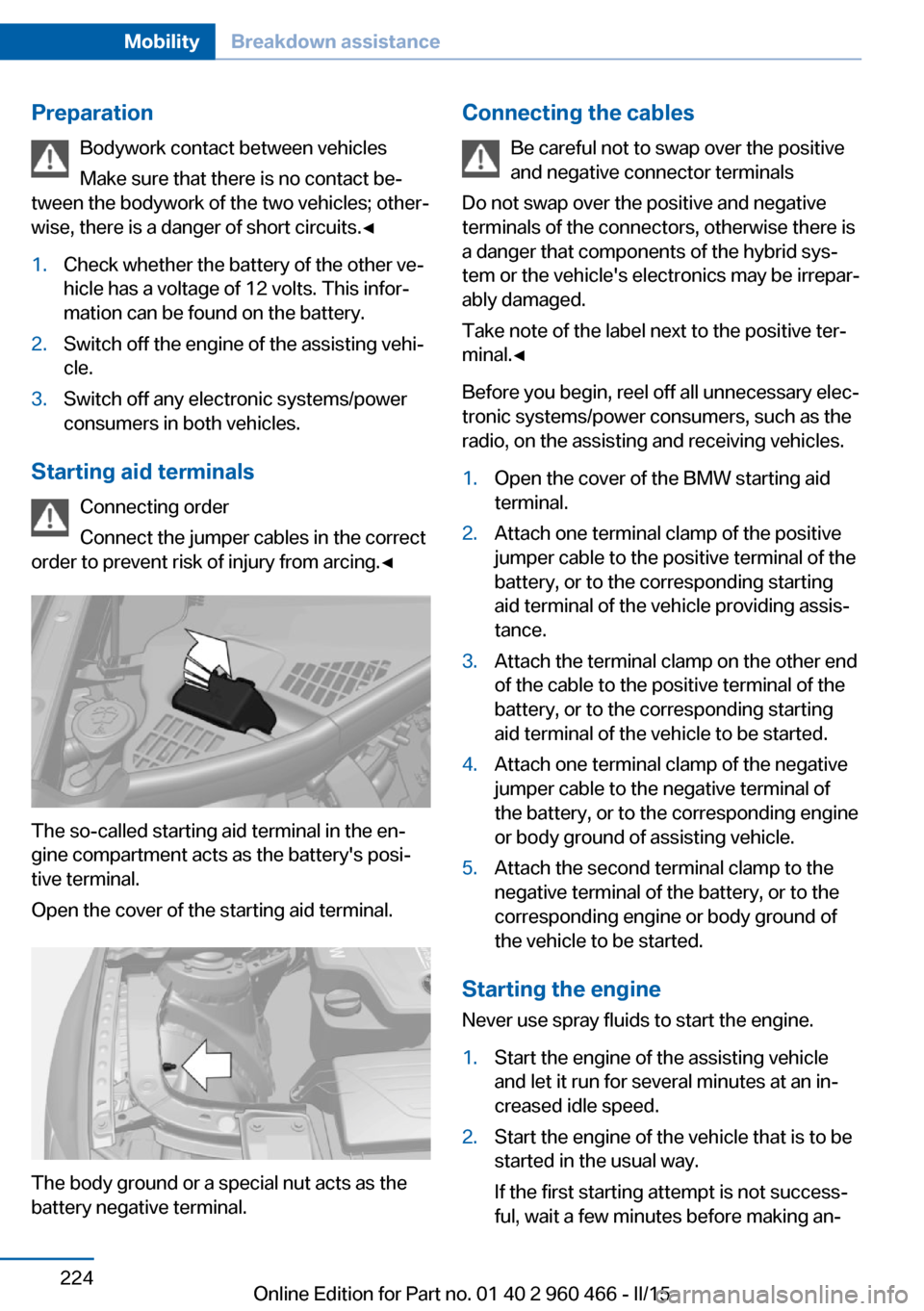
PreparationBodywork contact between vehicles
Make sure that there is no contact be‐
tween the bodywork of the two vehicles; other‐
wise, there is a danger of short circuits.◀1.Check whether the battery of the other ve‐
hicle has a voltage of 12 volts. This infor‐
mation can be found on the battery.2.Switch off the engine of the assisting vehi‐
cle.3.Switch off any electronic systems/power
consumers in both vehicles.
Starting aid terminals
Connecting order
Connect the jumper cables in the correct
order to prevent risk of injury from arcing.◀
The so-called starting aid terminal in the en‐
gine compartment acts as the battery's posi‐
tive terminal.
Open the cover of the starting aid terminal.
The body ground or a special nut acts as the
battery negative terminal.
Connecting the cables
Be careful not to swap over the positive
and negative connector terminals
Do not swap over the positive and negative
terminals of the connectors, otherwise there is
a danger that components of the hybrid sys‐
tem or the vehicle's electronics may be irrepar‐
ably damaged.
Take note of the label next to the positive ter‐
minal.◀
Before you begin, reel off all unnecessary elec‐
tronic systems/power consumers, such as the
radio, on the assisting and receiving vehicles.1.Open the cover of the BMW starting aid
terminal.2.Attach one terminal clamp of the positive
jumper cable to the positive terminal of the
battery, or to the corresponding starting
aid terminal of the vehicle providing assis‐
tance.3.Attach the terminal clamp on the other end
of the cable to the positive terminal of the
battery, or to the corresponding starting
aid terminal of the vehicle to be started.4.Attach one terminal clamp of the negative
jumper cable to the negative terminal of
the battery, or to the corresponding engine
or body ground of assisting vehicle.5.Attach the second terminal clamp to the
negative terminal of the battery, or to the
corresponding engine or body ground of
the vehicle to be started.
Starting the engine
Never use spray fluids to start the engine.
1.Start the engine of the assisting vehicle
and let it run for several minutes at an in‐
creased idle speed.2.Start the engine of the vehicle that is to be
started in the usual way.
If the first starting attempt is not success‐
ful, wait a few minutes before making an‐Seite 224MobilityBreakdown assistance224
Online Edition for Part no. 01 40 2 960 466 - II/15
Page 229 of 251
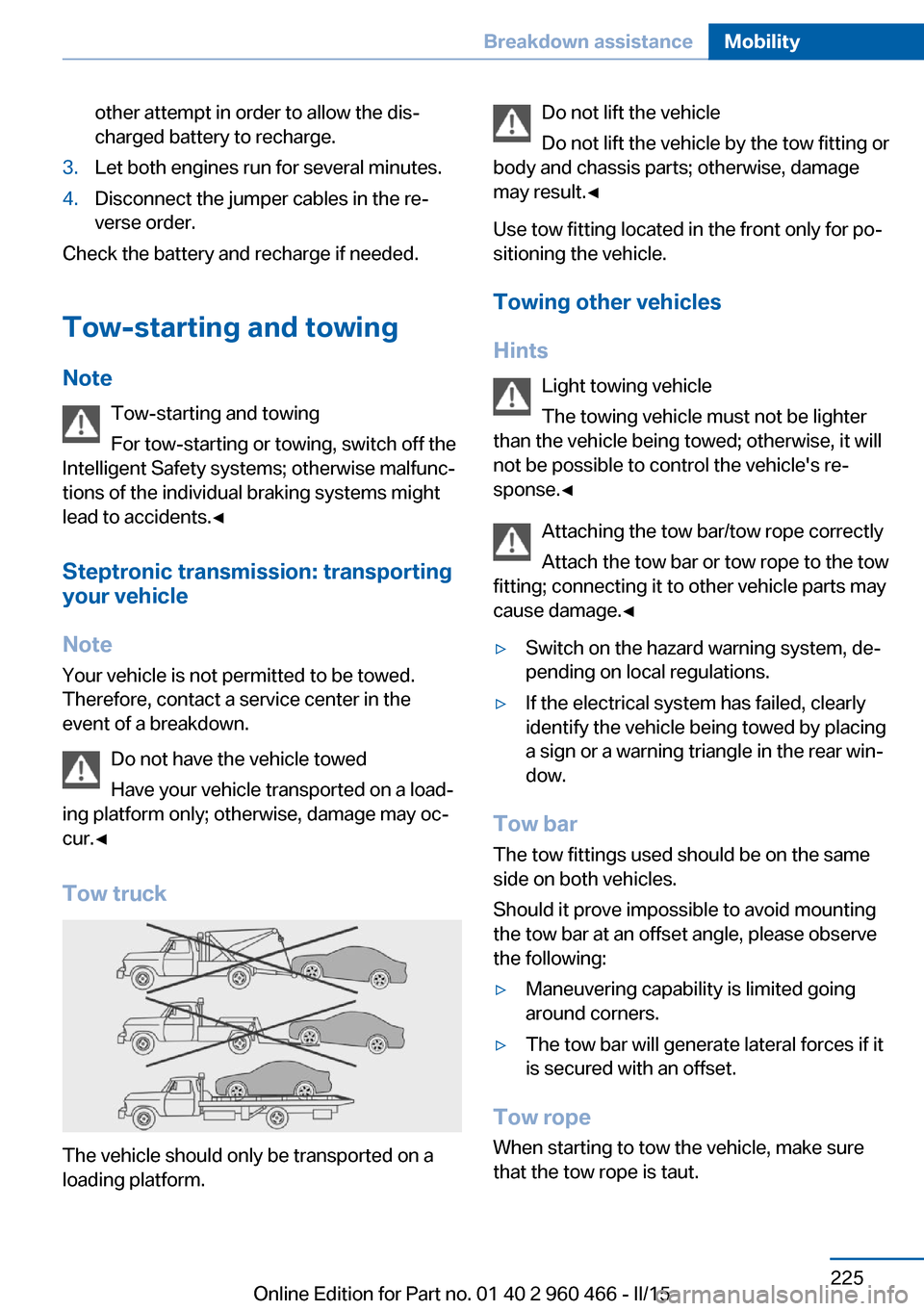
other attempt in order to allow the dis‐
charged battery to recharge.3.Let both engines run for several minutes.4.Disconnect the jumper cables in the re‐
verse order.
Check the battery and recharge if needed.
Tow-starting and towing Note Tow-starting and towing
For tow-starting or towing, switch off the
Intelligent Safety systems; otherwise malfunc‐
tions of the individual braking systems might
lead to accidents.◀
Steptronic transmission: transporting
your vehicle
Note Your vehicle is not permitted to be towed.
Therefore, contact a service center in the
event of a breakdown.
Do not have the vehicle towed
Have your vehicle transported on a load‐
ing platform only; otherwise, damage may oc‐
cur.◀
Tow truck
The vehicle should only be transported on a
loading platform.
Do not lift the vehicle
Do not lift the vehicle by the tow fitting or
body and chassis parts; otherwise, damage
may result.◀
Use tow fitting located in the front only for po‐
sitioning the vehicle.
Towing other vehicles
Hints Light towing vehicle
The towing vehicle must not be lighter
than the vehicle being towed; otherwise, it will
not be possible to control the vehicle's re‐
sponse.◀
Attaching the tow bar/tow rope correctly
Attach the tow bar or tow rope to the tow
fitting; connecting it to other vehicle parts may
cause damage.◀▷Switch on the hazard warning system, de‐
pending on local regulations.▷If the electrical system has failed, clearly
identify the vehicle being towed by placing
a sign or a warning triangle in the rear win‐
dow.
Tow bar
The tow fittings used should be on the same
side on both vehicles.
Should it prove impossible to avoid mounting
the tow bar at an offset angle, please observe
the following:
▷Maneuvering capability is limited going
around corners.▷The tow bar will generate lateral forces if it
is secured with an offset.
Tow rope
When starting to tow the vehicle, make sure
that the tow rope is taut.
Seite 225Breakdown assistanceMobility225
Online Edition for Part no. 01 40 2 960 466 - II/15
Page 241 of 251
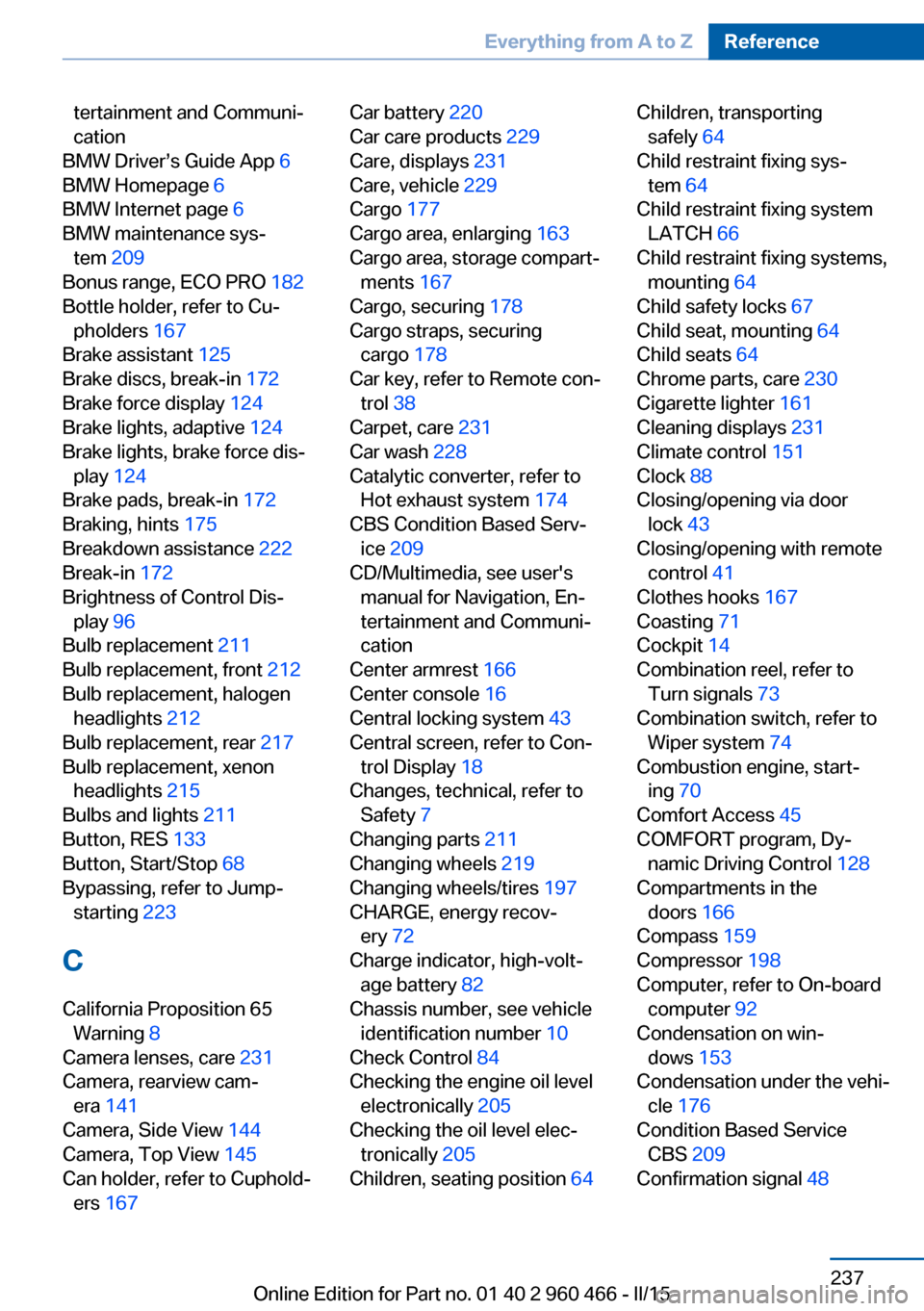
tertainment and Communi‐
cation
BMW Driver’s Guide App 6
BMW Homepage 6
BMW Internet page 6
BMW maintenance sys‐ tem 209
Bonus range, ECO PRO 182
Bottle holder, refer to Cu‐ pholders 167
Brake assistant 125
Brake discs, break-in 172
Brake force display 124
Brake lights, adaptive 124
Brake lights, brake force dis‐ play 124
Brake pads, break-in 172
Braking, hints 175
Breakdown assistance 222
Break-in 172
Brightness of Control Dis‐ play 96
Bulb replacement 211
Bulb replacement, front 212
Bulb replacement, halogen headlights 212
Bulb replacement, rear 217
Bulb replacement, xenon headlights 215
Bulbs and lights 211
Button, RES 133
Button, Start/Stop 68
Bypassing, refer to Jump- starting 223
C
California Proposition 65 Warning 8
Camera lenses, care 231
Camera, rearview cam‐ era 141
Camera, Side View 144
Camera, Top View 145
Can holder, refer to Cuphold‐ ers 167 Car battery 220
Car care products 229
Care, displays 231
Care, vehicle 229
Cargo 177
Cargo area, enlarging 163
Cargo area, storage compart‐ ments 167
Cargo, securing 178
Cargo straps, securing cargo 178
Car key, refer to Remote con‐ trol 38
Carpet, care 231
Car wash 228
Catalytic converter, refer to Hot exhaust system 174
CBS Condition Based Serv‐ ice 209
CD/Multimedia, see user's manual for Navigation, En‐
tertainment and Communi‐
cation
Center armrest 166
Center console 16
Central locking system 43
Central screen, refer to Con‐ trol Display 18
Changes, technical, refer to Safety 7
Changing parts 211
Changing wheels 219
Changing wheels/tires 197
CHARGE, energy recov‐ ery 72
Charge indicator, high-volt‐ age battery 82
Chassis number, see vehicle identification number 10
Check Control 84
Checking the engine oil level electronically 205
Checking the oil level elec‐ tronically 205
Children, seating position 64 Children, transporting
safely 64
Child restraint fixing sys‐ tem 64
Child restraint fixing system LATCH 66
Child restraint fixing systems, mounting 64
Child safety locks 67
Child seat, mounting 64
Child seats 64
Chrome parts, care 230
Cigarette lighter 161
Cleaning displays 231
Climate control 151
Clock 88
Closing/opening via door lock 43
Closing/opening with remote control 41
Clothes hooks 167
Coasting 71
Cockpit 14
Combination reel, refer to Turn signals 73
Combination switch, refer to Wiper system 74
Combustion engine, start‐ ing 70
Comfort Access 45
COMFORT program, Dy‐ namic Driving Control 128
Compartments in the doors 166
Compass 159
Compressor 198
Computer, refer to On-board computer 92
Condensation on win‐ dows 153
Condensation under the vehi‐ cle 176
Condition Based Service CBS 209
Confirmation signal 48 Seite 237Everything from A to ZReference237
Online Edition for Part no. 01 40 2 960 466 - II/15
Page 243 of 251
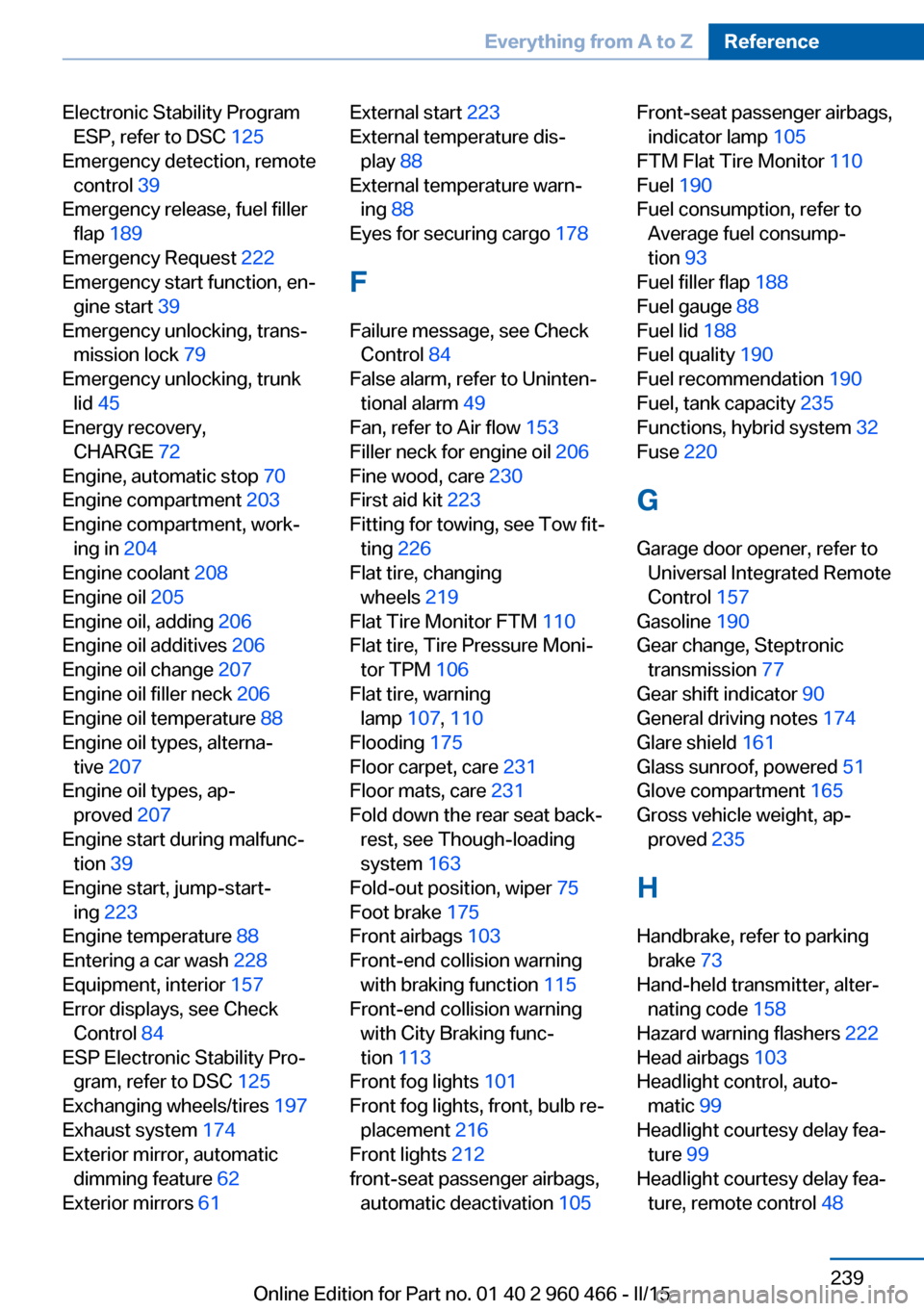
Electronic Stability ProgramESP, refer to DSC 125
Emergency detection, remote control 39
Emergency release, fuel filler flap 189
Emergency Request 222
Emergency start function, en‐ gine start 39
Emergency unlocking, trans‐ mission lock 79
Emergency unlocking, trunk lid 45
Energy recovery, CHARGE 72
Engine, automatic stop 70
Engine compartment 203
Engine compartment, work‐ ing in 204
Engine coolant 208
Engine oil 205
Engine oil, adding 206
Engine oil additives 206
Engine oil change 207
Engine oil filler neck 206
Engine oil temperature 88
Engine oil types, alterna‐ tive 207
Engine oil types, ap‐ proved 207
Engine start during malfunc‐ tion 39
Engine start, jump-start‐ ing 223
Engine temperature 88
Entering a car wash 228
Equipment, interior 157
Error displays, see Check Control 84
ESP Electronic Stability Pro‐ gram, refer to DSC 125
Exchanging wheels/tires 197
Exhaust system 174
Exterior mirror, automatic dimming feature 62
Exterior mirrors 61 External start 223
External temperature dis‐ play 88
External temperature warn‐ ing 88
Eyes for securing cargo 178
F
Failure message, see Check Control 84
False alarm, refer to Uninten‐ tional alarm 49
Fan, refer to Air flow 153
Filler neck for engine oil 206
Fine wood, care 230
First aid kit 223
Fitting for towing, see Tow fit‐ ting 226
Flat tire, changing wheels 219
Flat Tire Monitor FTM 110
Flat tire, Tire Pressure Moni‐ tor TPM 106
Flat tire, warning lamp 107, 110
Flooding 175
Floor carpet, care 231
Floor mats, care 231
Fold down the rear seat back‐ rest, see Though-loading
system 163
Fold-out position, wiper 75
Foot brake 175
Front airbags 103
Front-end collision warning with braking function 115
Front-end collision warning with City Braking func‐
tion 113
Front fog lights 101
Front fog lights, front, bulb re‐ placement 216
Front lights 212
front-seat passenger airbags, automatic deactivation 105 Front-seat passenger airbags,
indicator lamp 105
FTM Flat Tire Monitor 110
Fuel 190
Fuel consumption, refer to Average fuel consump‐
tion 93
Fuel filler flap 188
Fuel gauge 88
Fuel lid 188
Fuel quality 190
Fuel recommendation 190
Fuel, tank capacity 235
Functions, hybrid system 32
Fuse 220
G
Garage door opener, refer to Universal Integrated Remote
Control 157
Gasoline 190
Gear change, Steptronic transmission 77
Gear shift indicator 90
General driving notes 174
Glare shield 161
Glass sunroof, powered 51
Glove compartment 165
Gross vehicle weight, ap‐ proved 235
H
Handbrake, refer to parking brake 73
Hand-held transmitter, alter‐ nating code 158
Hazard warning flashers 222
Head airbags 103
Headlight control, auto‐ matic 99
Headlight courtesy delay fea‐ ture 99
Headlight courtesy delay fea‐ ture, remote control 48 Seite 239Everything from A to ZReference239
Online Edition for Part no. 01 40 2 960 466 - II/15
Page 248 of 251
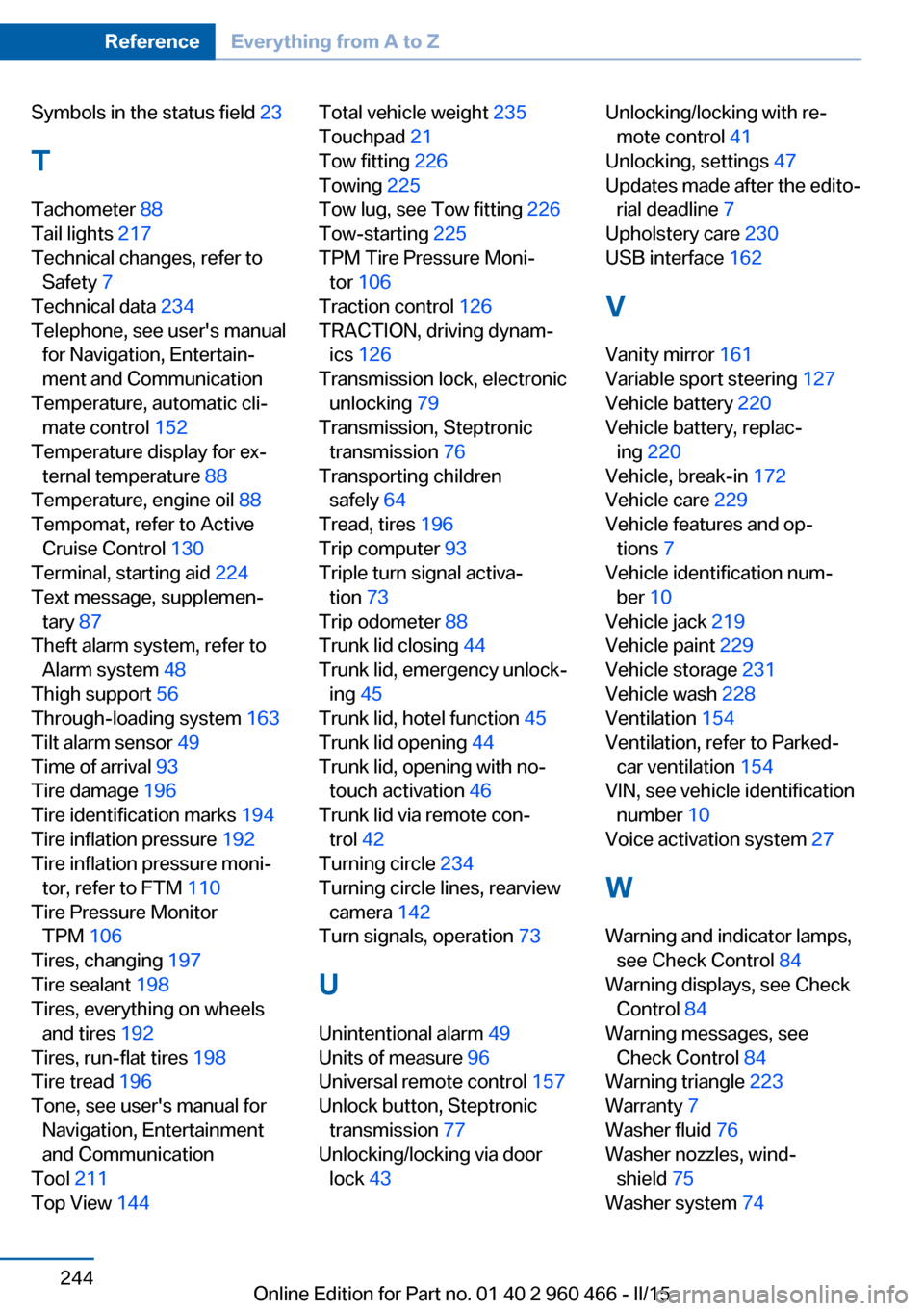
Symbols in the status field 23
T Tachometer 88
Tail lights 217
Technical changes, refer to Safety 7
Technical data 234
Telephone, see user's manual for Navigation, Entertain‐
ment and Communication
Temperature, automatic cli‐ mate control 152
Temperature display for ex‐ ternal temperature 88
Temperature, engine oil 88
Tempomat, refer to Active Cruise Control 130
Terminal, starting aid 224
Text message, supplemen‐ tary 87
Theft alarm system, refer to Alarm system 48
Thigh support 56
Through-loading system 163
Tilt alarm sensor 49
Time of arrival 93
Tire damage 196
Tire identification marks 194
Tire inflation pressure 192
Tire inflation pressure moni‐ tor, refer to FTM 110
Tire Pressure Monitor TPM 106
Tires, changing 197
Tire sealant 198
Tires, everything on wheels and tires 192
Tires, run-flat tires 198
Tire tread 196
Tone, see user's manual for Navigation, Entertainment
and Communication
Tool 211
Top View 144 Total vehicle weight 235
Touchpad 21
Tow fitting 226
Towing 225
Tow lug, see Tow fitting 226
Tow-starting 225
TPM Tire Pressure Moni‐ tor 106
Traction control 126
TRACTION, driving dynam‐ ics 126
Transmission lock, electronic unlocking 79
Transmission, Steptronic transmission 76
Transporting children safely 64
Tread, tires 196
Trip computer 93
Triple turn signal activa‐ tion 73
Trip odometer 88
Trunk lid closing 44
Trunk lid, emergency unlock‐ ing 45
Trunk lid, hotel function 45
Trunk lid opening 44
Trunk lid, opening with no- touch activation 46
Trunk lid via remote con‐ trol 42
Turning circle 234
Turning circle lines, rearview camera 142
Turn signals, operation 73
U Unintentional alarm 49
Units of measure 96
Universal remote control 157
Unlock button, Steptronic transmission 77
Unlocking/locking via door lock 43 Unlocking/locking with re‐
mote control 41
Unlocking, settings 47
Updates made after the edito‐ rial deadline 7
Upholstery care 230
USB interface 162
V Vanity mirror 161
Variable sport steering 127
Vehicle battery 220
Vehicle battery, replac‐ ing 220
Vehicle, break-in 172
Vehicle care 229
Vehicle features and op‐ tions 7
Vehicle identification num‐ ber 10
Vehicle jack 219
Vehicle paint 229
Vehicle storage 231
Vehicle wash 228
Ventilation 154
Ventilation, refer to Parked- car ventilation 154
VIN, see vehicle identification number 10
Voice activation system 27
W Warning and indicator lamps, see Check Control 84
Warning displays, see Check Control 84
Warning messages, see Check Control 84
Warning triangle 223
Warranty 7
Washer fluid 76
Washer nozzles, wind‐ shield 75
Washer system 74 Seite 244ReferenceEverything from A to Z244
Online Edition for Part no. 01 40 2 960 466 - II/15